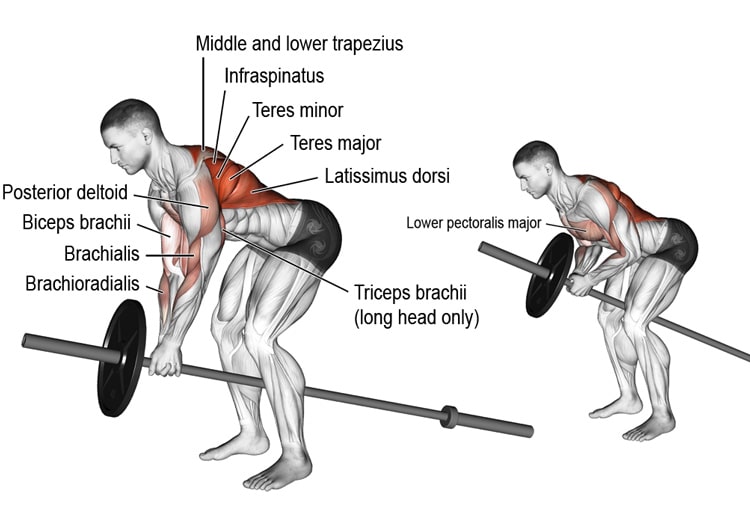Tag: guide

How To Gain Muscle Mass Quickly – A Guide On What To Eat And How To Train
Put On Muscle Mass Using This Technique
Many people quit the fit lifestyle when they join a gym to put on muscle mass but can’t see the weight scale budge in the right direction. Most people want to get results in the shortest time.
If you want to put on muscle on a timeline, you can’t afford to go wrong with the training, diet, and recovery. In this article, we’ll show you the way by telling you everything you need to know about gaining muscle on a deadline using a technique.
Setting The Right Target
Before you begin your transformation, you need to make sure you’re setting achievable goals. To keep your bulking phase sustainable, we suggest not wanting to put on more than 2lbs weight every week.
Whatever your diet is right now, add 500 calories to it if you want to put on 1lbs weight in one week. Adding 1,000 calories to your diet can speed up the bulking process and help you gain up to 2lbs a week.
How To Train To Put On Muscle Mass
Earlier, people used to overlook their diet when it came to building muscle but now a personalized training program has taken its place. Many people think that they will put on muscle mass irrespective of how they train unless their diet is right.
You can’t afford to put the training program on the back seat. If training routines were so inconsequential, the pros wouldn’t be spending thousands of dollars every month on their coaches trying to fine-tune their exercise routines, numbers of sets and reps they perform.
Designing The Right Training Program
If you’re a beginner or want to do a transformation, you should give your body at least 12 weeks to show major improvements. We would suggest you divide the 12 weeks into 3-week training routine splits.
3-weeks is the right amount of time for your body to get the most out of your workouts without letting it adjust to your routine. Change the intensity of your workouts week-on-week to push your muscles as you get closer to the 12-week mark.
For example – start your training program with a vanilla training program where you perform five exercises in a workout and do 3 sets of 10-12 reps. In the second week, switch to the German Volume Training (GVT) where you do 10 sets of 1 exercise before moving on to other exercises.
In the last week, you should increase the intensity of your workouts in a way that you’re only doing 3 exercises but are performing 5-7 sets and 15-30 reps on each lift. The increase in intensity will help in conditioning your muscles.
What And How Much To Eat To Put On Muscle Mass
If you’re planning to build muscle mass, your goal should be to eat around 3,000 calories a day. Of these 3,000 calories, 40% should come through carbs and the remaining 30% from proteins and fats each.
If your weight (muscle mass) isn’t increasing at the required pace, bump up your calories by 500 every time. We would suggest you wait for three weeks before modifying your diet. You need to give your body enough time to respond to your diet and training program.
You also need to make sure your recovery is on point. None of the diet and training improvements will do you any good until you’re recovery well. You should be sleeping between 7-8 hours every night.
How many calories a day do you eat currently? Let us know in the comments below. Also, be sure to follow Generation Iron on Facebook, Twitter, and Instagram.
Header image courtesy of Envato Elements

How to Lean Bulk – The Ultimate Guide
How to Lean Bulk – The Ultimate Guide
Before we get to to the million-dollar question, let’s talk about “bulking”. Lean bulking is such a misunderstood concept that most people who start a bulk end up gaining a belly. For a few minutes, forget everything you’ve been told about bulking by the bros.
Bulking cycle is a period of time where you eat surplus calories to gain muscle mass and strength. The sad and inevitable part of a bulking program is that an aggressive caloric surplus state will invariably lead you to put on body fat.
In an effective bulking plan, you should be increasing your training intensity and frequency. Adding more load and volume will provide ample stimulation to your muscles and will make sure you’re not adding too much to your fat reserves.
Like all good things, a bulking period has to come to an end. In the “cutting” phase you will cut the fluff from your body by adding HIIT cardio to your training program and by cutting the carbs and fats from your diet.
Pre-Requisites of a Lean Bulk –
Don’t Eat Like It’s The Last Meal of Your Life
Some people think that a bulking diet is synonymous with cheat meals. You can’t and shouldn’t eat anything you can get your hands on. Just like any other bodybuilding program, you’ll have to follow a strict diet plan for a lean and clean bulk.
A Bulk is Not For Everyone
Probably the biggest misconception about bulk is that anyone can do it. If you’re a newbie or don’t have any gains to show, forget lean bulking. The first goal should be to put on quality muscle mass.
You should only consider bulking if your current body fat percentage is at or around 10-12%. If you’re around 15-20% body fat, you’re already too bulky to start a new lean bulking program.
Calculating Your Caloric & Macronutrient Needs For Lean Bulking
Starting a lean bulking program without knowing the exact amount of calories and macronutrients you need is a recipe for disaster. As someone rightly said, “If you fail to plan, you’re planning to fail.”
If you don’t follow a strict diet, you’ll most likely end up stuffing yourself with empty calories and saturated fats. Ask anyone on a bulking schedule about his exact daily calorie goals and they might tell you that the whole point of a bulking program is to put on size without fussing too much about tracking calories.
Designing Your Diet
The first step in designing the bulking diet is to calculate your BMR. BMR (basal metabolic rate) is the amount of energy required by your body while resting in a temperate environment when the digestive system is inactive. Calculating your BMR is equivalent to figuring out how much gas your idle car consumes while parked.
After calculating BMR, it’s time to compute your TDEE (Total daily energy expenditure) with this formula:
TDEE is the exact number of calories your body needs to maintain itself. In a bulking program, you need to add a surplus to put on some muscle mass. Most people make the mistake of adding too many calories to their diet. In a bulking program, you don’t need more than 200-300 calories to be in a healthy and effective surplus state.
Finding Your Daily Macronutrient Needs
While this might feel a little complicated but learning these steps will put you in total control of your body, and you won’t need a dietician ever again to help with your transformations.
Each macronutrient has a certain amount of calories per gram. While fats contain nine calories per gram, protein and carbs contain four calories per gram each. We won’t get into the roles of each macronutrient as it is out of the scope of the article but each macronutrient is indispensable to the success of your lean bulk.
Starting with Protein
Protein is the muscle’s building block and arguably the most important macronutrient when it comes to gaining muscle size. According to some studies, you need 1 gram of protein per pound of bodyweight to put on muscle mass.
After you calculate your daily required calories using TDEE, you need to gauge your daily protein need. 40:30:30 (carbs: protein: fats) is a dependable macronutrient split for bulking. If your total required calories are 2400kcal, you’ll need 960kcal (2400X40%) coming from protein. You need to be eating 240 grams (960/4) of protein every day to put on muscle mass.
Carbs & Fats Come Second
Calculate your required fats the same way. You’ll need 720 calories (2400X30%) and 80 grams (720/9) of fats. Carbs are calculated by adding the required calories from protein and fats and deducting them from the total amount of required calories.
In this case, you’ll need 720kcal [2400-(960+720)] and 180 grams (720/4) of carbohydrates. The next step would be to use an app like MyFitnessPal to design your meal plan as per your macro goals.
Now that you know this system, you never have to consult a nutritionist for designing a diet plan, your welcome.
Three Main Kinds of Bulks
The Relaxed Bulk
The relaxed bulk is probably the most common type of bulk. It doesn’t require any calorie or macronutrient tracking. You eat the usual food (in higher quantities) and gain a decent amount of muscle mass. People also run the risk of gaining a higher amount of fat in the process.
The Lean Bulk
The lean bulk is what most people want to do but end up doing the relaxed bulk because of a lack of knowledge. It is the structured approach to bulking where you track your calories and macronutrients. In the lean bulk, you gain maximum muscle and minimum fat.
The Maintenance Bulk
Maintenance bulk is very similar to lean bulk. The only difference here is that you won’t be eating the surplus 200-300 calories. Eating right around the maintenance level will in theory only make you gain muscle mass and no fat.
Tracking Your Progress
Tracking progress is one of the most overlooked aspects of lean bulking. You need to know the realistic rate of muscle growth to be able to track and compare your progress. Your bulk progress will depend on your training experience.
Training experience can be categorized in a few different ways, with the most popular one developed by Lyle McDonald. His method is based on years of proper training:
Have you ever tried lean bulking? Let us know in the comments below. Also, be sure to follow Generation Iron on Facebook and Twitter.

